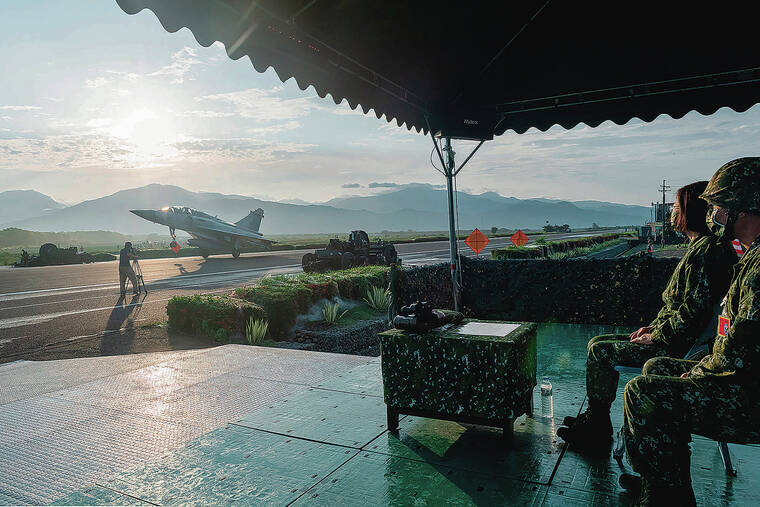A runway at Daniel K. Inouye International Airport that was blocked Monday afternoon when an F-16 belonging to the Taiwanese air force made an emergency crash landing did not sustain any serious damage and has resumed normal operations, according to the state Department of Transportation.
The incident has put the complicated relationship between the United States and Taiwan in the spotlight amid tensions with China in the Pacific.
A spokesperson for U.S. Indo-Pacific Command told the Honolulu Star-Advertiser she was “not at liberty” to discuss the condition of the plane or the pilot. U.S. officials Tuesday told The Associated Press that a U.S. Air Force pilot who was flying the Taiwanese aircraft was taken to the hospital but was not seriously injured.
DOT officials said the plane appeared to suffer only minor damage.
A military official in Hawaii with knowledge of the flight told the Star-Advertiser it was part of a “routine ferry mission” in which American pilots fly planes to and from Taiwan as part of an “ongoing security assistance program” that falls under the U.S. State Department and its foreign military sales program.
The U.S. routinely sells F-16s to Taiwan. Officials told the AP that the pilot took off from an Air Force base on the mainland and was scheduled to stop in Hawaii en route to Taiwan.
The U.S. has programs to retrofit and upgrade older models of the F-16 for Taiwan, as well as plans to deliver new models of the aircraft. It wasn’t clear whether the fighter jet that crash-landed Monday was new or an older version.
Since the U.S. normalized relations with the People’s Republic of China in 1979, it has not officially diplomatically recognized Taiwan. China regards Taiwan as a rogue province, and Chinese President Xi Jinping has vowed to bring it under Beijing’s control.
However, the Taiwan Relations Act of 1979 affirmed de facto relations between the U.S. and Taiwan. The act also requires the U.S. “to provide Taiwan with arms of a defensive character” and “to maintain the capacity of the United States to resist any resort to force or other forms of coercion that would jeopardize the security, or the social or economic system, of the people on Taiwan.”
Hawaii has been quietly used as a transit point for warplanes making their way between Taiwan and the mainland.
In May 2021, Instagram user Aeros808, a local account that posts aviation photos, uploaded photos of two F-16s passing through the Honolulu airport. One displayed the serial number 6621 — a Taiwanese military number. The photos spurred discussion in Taiwanese media and among online aviation enthusiasts.
The Taiwanese warplanes and airmen — sometimes separately — most often make their way to Luke Air Force Base in Arizona, a major training ground for foreign pilots. There the Taiwanese military pilots and ground crews work with the U.S. Air Force’s 21st Fighter Squadron, which operates Taiwanese-owned F-16s alongside their Taiwanese counterparts as they conduct flight and maintenance training.
The training is rarely discussed publicly, but in January 2016 American officials acknowledged the death of a Taiwanese pilot after his F-16 crashed north of Luke near the town of Bagdad, Ariz.
In recent years China has tested Taiwan’s defenses by sending warplanes into the island’s airspace in increasing numbers and with increasing frequency. Russia’s ongoing war in Ukraine has prompted analysts and military commanders to express concerns that China might be inching closer to an invasion of Taiwan.
In March, Adm. John Aquilino, commander of U.S. Indo-Pacific Command at Camp Smith and the top U.S. military leader in the Pacific, told the Financial Times, “I wouldn’t say I’m more concerned, but I do see increased pressure, and we have to make sure we are prepared should any actions get taken.”
———
The Associated Press contributed to this report.

